Ciao, readers! I am the National Wine Educator of the Month for the Society of Wine Educators. The Society is posting a series of my articles, pertaining to wine educators – but if you ask me, there are gems in there for everyone to enjoy. This week’s article is about the many benefits (for educator and client alike) of incorporating the local wine scene into wine education activities. So get in the car and explore your territory! Here is the article link.
Greetings, my friends! My hands have been full with exciting new projects on several fronts, but I am still here! In fact, this month, I am honored to have been chosen as the Society of Wine Educators’ National Educator of the Month. Once a week, for the next four weeks, I will be sharing an article of mine with the Society — and with you, my esteemed readers.
This week’s article is about being proud of our many sides, and not being afraid to showcase all that we are, even in perceived “niche” professions. Whether or not you are a wine educator, apply these tips to your own personal and professional branding! As always, I enjoy your comments so please feel free to share. Click here to view the full article.
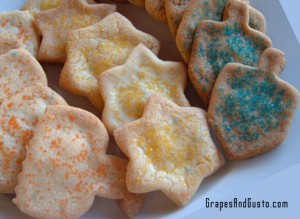
I couldn't help but display my Chanukah cookies instead of photos of wine...they came out so nicely!
Combining family, food and festivities, Hanukkah is truly a holiday experienced through the senses. Add some wine to the mix with these tailored tips, and you’ll up the simcha factor faster than a spinning dreidel.
With wine, it is important to relax and ultimately drink what you enjoy. Hanukkah’s treats and wintry backdrop provide just the occasion to experiment with food pairings. The first four tips offer advice on tasting and pairing.
1. Discover the new kosher wines. Gone are the days of kosher wines being synonymous with thick, syrupy concoctions (though these can get quite tasty during a four-cup seder). Today’s kosher wines, from Israel to the U.S. and even Australia, have begun garnering serious awards, and are redefining our concept of Jewish wines for the chagim.
2. Hanukkat Bayit. In Hebrew, Hanukkah means “rededication,” and what better way to celebrate this cozy festival of lights than to host a Hanukkah wine tasting with good friends, featuring – symbolically – eight wines for the group to try.
3. The new pairing theory. Did you know that the old “red wine with red meat, white wines with white meat” adage was born post-World War II, as an attempt by European wine promoters to target the steak-happy U.S. market? Some exceptions apply to that rule, such as the classic pairing of Pinot Noir and salmon, so modern wine specialists recommend pairing foods and wines that share equal heft or intensity of flavor, so as not to overwhelm one of the components. For example, chicken with herbs may be delicate enough for a white Chenin Blanc, but with a dark mushroom sauce, the chicken may be better suited to a red Beaujolais or Burgundy.
4. Wine’s yin and yang. Another simple pairing strategy is to take shared elements found in a food and a wine, and pair them in a complementary manner. Think of a crispy, fried latke and a buttery, oaked Chardonnay, both sharing a heavy richness on the tongue. An equally intriguing palate pleaser results from contrasting two elements – such as that hot, oily latke with a sip of crisp, clean Sauvignon Blanc, a delicate wine whose citruslike acidity cuts through the oil and cleanses the palate.
While the true essence of Hanukkah hardly emphasizes presents, it helps to have a plan for purchasing wines for a special friend, colleague or hostess. These next four strategies will keep your gift in their hearts long after the eighth candle has waned.
5. Pick a relevant region. Today, all 50 states make wine. If you have a loved one who will be visiting from New York, for example, why not give them a bottle of fine, red Meritage from the North Fork of Long Island?
6. Mark a meaningful year. Perhaps your niece got engaged in 2003. Why not track down a case or a magnum (large-format bottle) of a rich Cabernet Sauvignon from that vintage year?
7. Hone in on a hobby. With an abundance of clever winery names and creative labels available, this is one time when judging a book by its cover is encouraged. There are wine labels with favorite animals, tongue-in-cheek humor or even a sultry bottle of Marilyn Merlot for the fans.
8. Bundle wines from Israel and the Diaspora. Give a multiple gift by selecting the recipient’s favorite type of wine and gathering an Israeli version along with one from the U.S., Australia or Europe. Call this the “Nes Gadol Haya Po v’Sham” gift: A great miracle happened here and there!
Spanning the globe and various budgets, here are three kosher wines that pair smartly with Hanukkah fare.
Sauvignon Blanc: Goose Bay Sauvignon Blanc
The signature citrus and gooseberry flavor combination put Marlborough, New Zealand, on the world map for notable Sauvignon Blanc production, and this example is just that – and perfect as a crisp contrast to hot latkes.
(White wine from New Zealand. Kashrut index: Mevushal, OU. Approximately $16/bottle)
Chardonnay: Altoona Hills Chardonnay
The full-bodied fruit and creamy oak essence lend a vibrant touch to this classic white sipper. With an exceptionally rich structure, this Australian landmark wine can easily complement any oil-laden Hanukkah treats.
(White wine from Australia. Kashrut index: Mevushal, OU. Approximately $8/bottle)
Pinot Noir: Galil Pinot Noir
This Israeli gem demonstrates the fruit-forward New World style of Pinot Noir, featuring tangy, earthy notes that showcase signature sour cherries and berries. Food-friendly and versatile, it is equally at home with schnitzel, mushroom-based dishes or grilled salmon. (Red wine from Israel. Kashrut index: Non-mevushal, OK. Approximately $19/bottle)
Gilat Ben-Dor, MBA, CSW is a wine educator and sommelier. She is the director of Renaissance Wine Academy™ in Scottsdale, Arizona, which offers wine education, keynote speaking, and consulting for corporate and private clients. Visit RenaissanceWineAcademy.com for more details.
© Gilat Ben-Dor, 2008-2010.
Tags: Chanukah, Entertaining, Food, food and wine pairing, holidays, Wine
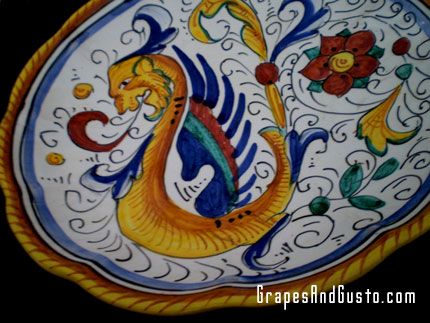
This lively, stylized dragon is a signature mark on the classic Raffaellesco pattern used on many Deruta majolica pieces. Pictured here is a plate from my personal collection.
Who am I to judge those who obsess over the dining chairs of an obscure designer, or those deranged fans of discontinued lipstick shades, hunting down the last remaining world supply with cold-sweat fervor? Not I. I will readily own up to my own unique brand of fascination: Italian majolica (pronounced “maYOLica”, and sometimes spelled maiolica). Majolica is pottery painted in a protected Renaissance tradition in the town of Deruta, in the region of Umbria. For those cooking-lesson villa renters out there, and fans of “Under the Tuscan Sun,” you may know Umbria as the region just southeast of Tuscany.
But Deruta pottery is so much more than some hand-painted flourishes scrawled on a fruit bowl. Deruta pottery comes in a variety of historic designs, which I will point out shortly. But aside from the rich tradition surrounding Deruta wares, I make the audacious claim that a Deruta dinner plate changed my life.
A dinner plate?
Yes – and from an early age, too. As a child, I used to play at the home of our family friends where I discovered an untapped passion. This couple has led tours to Italy for many years, particularly based around the Renaissance capital of Florence. In their home, I grew up gazing at the large, glamorous photos of them standing proudly in front of medieval architecture, and with wind-blown smiles atop city panoramas. Dressed in stylish gear, gelato in hand, they posed on gondolas and beside clock towers. I loved being in their home, surrounded by volumes of glossy art books, and the cozy luxury of rugs and artwork in every cranny.
But perhaps most of all, it was their elegant, stylish dinner parties (viewed from my vantage point at the “kids’ table”) that intrigued me the most. This is where I witnessed their never-ending parade of Deruta pottery: ceramic candlesticks whose colorful designs glowed amid the din of group laughter; platters sturdy enough to hold plump piles of veal piccata and hearty helpings of pesto linguine, and yet charming and poised enough to grace a table fit for Company.
Damn the kids’ table, I thought, as I gazed at my hot dogs n’ beans.
It was during one of these entertaining affairs that I first saw it: Raffaellesco, the pattern of my dreams.
Lively, stylized dragons with tapering tails in rich shades of golden maize, accented with cobalt, brown and teal. More ornamentation than a Bach fugue, but it all worked cleanly against the crisp, white background. This is truly the spirit of the Renaissance, captured perfectly! I remember thinking, as I reached the flashpoint of my lifelong love of the Italian Renaissance.
The Raffaellesco pattern offers an experience both visually and energetically. It is regal and stately, yet fun and dynamic – a satisfying combination for those with modern formal tastes.

In this detail from an authentic Deruta plate, you can see the brushstrokes indicating true, hand-painted workmanship.
The name Raffaellesco is attributed to the Renaissance artist Raphael, who was thought to have painted a benevolent sea god meant to protect seafaring merchants on their journeys. The design stuck, as it is one of Deruta’s most famed and popular designs. Other classic Deruta designs include the colorful Ricco Deruta, considered the oldest and most traditional pattern in the Deruta tradition; Orvieto, a nod to rustic living with its cheerful, green roosters; Siena, an elegant, black-bordered collection featuring medieval-style flora and fauna; and the lively Arrabesco pattern, featuring birds and freeform decorations that evoke a more contemporary sensibility.
The town of Deruta takes its pottery traditions very seriously. The city houses what is widely considered the world’s foremost authority for the teaching of the Deruta majolica technique, the International School of Ceramic Art “Romero Ranieri.” All authentically created, local majolica pieces contain a special “Deruta” signature on their underside, usually hand-painted rather than stamped. The producers must follow strict design guidelines if they are to label their majolica pieces in the classic series. This handiwork does not come cheap, and even within the regulated producers, there is a spectrum of quality and refinement. For the real deal, expect to pay at least $100 for a dinner plate (yes, one dinner plate).
Recently, after a two year investigation, the Italian police uncovered a Deruta fraud ring. According to a March 10, 2010 article published at ThatsArte.com’s blog by Tiziana, “last February…Italian police charged the owners of three companies located in Assisi and Deruta with fraud and other administrative crimes. They manufactured fake Raffaellesco and Ricco Deruta pottery that was then partly sold to bus loads of unaware tourists visiting Assisi, partly exported to Europe, Japan and to the US at competitive prices.” The police seized over 2000 pieces that bore the coveted “Handpainted in Deruta” signature but which were actually decal transfer work.
The dramatic world of art fraud is far-reaching, I’m afraid. I have encountered several knock-offs in some of my own local home furnishing stores. It is easy to spot these knock-offs if you look closely. You will be able to see a tiny “dot matrix” printing texture instead of a smooth series of brushstrokes. To this, they will often hand-paint the rim of the plate which may add more of an authentic look to the unsuspecting eye. Sure, these are priced quite inexpensively, but like first-class air travel, once you’ve experienced the real deal, it’s hard to go back.

This hand-signed mark on the underside of a Deruta majolica piece indicates authenticity.
Not surprisingly, I ended up spending a blissful semester in Florence during my college days. I was thrilled when I found an affordable Deruta (or was I duped into buying “Deruta style”?) vendor stand in one of the piazzas. I bought a small Raffaellesco plate, but it then broke in transit back to the States. Since then, I have thirsted for more Deruta to ease that early disappointment. But a funny thing happens with these types of pursuits. Suddenly, one piece is no longer enough. The most insidious part of a “Deruta-ddiction” is that these beautiful pieces are also functional. The rationalizations can get out of hand. I mean, who couldn’t use a mezzaluna (crescent-shaped) cookie dish around the house, or a hand-painted biscotti jar to catch someone’s hands in?
Come on, you know you want a rooster-shaped pitcher.
To purchase Italian majolica in the U.S., visit the website of Biordi in San Francisco, California. There are many other purveyors of Italian majolica in the U.S., but Biordi carries some of the finest examples of majolica from Deruta and other regions. Their inventory spans from classic to more contemporary styles, and many items beyond tableware. You can even commission your own designs through them.
© Gilat Ben-Dor, 2010. All rights reserved.
Tags: art, Entertaining, Italy, passion, Tableware

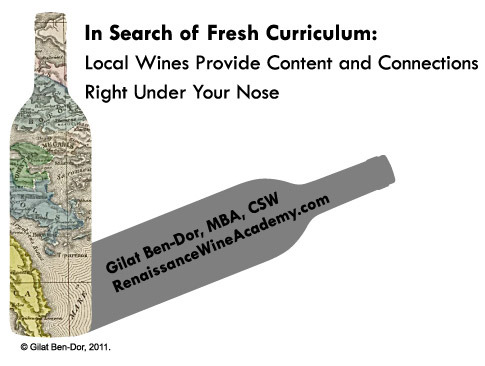

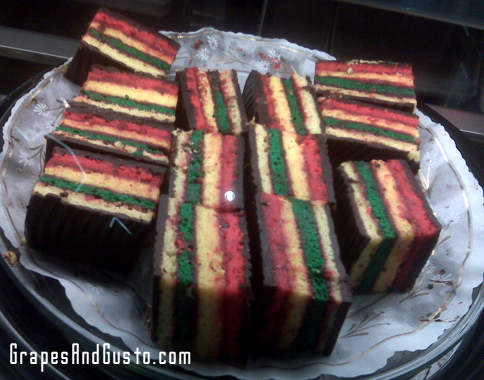
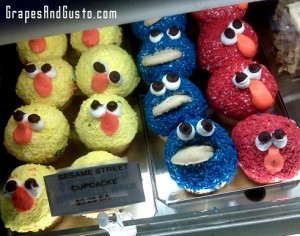
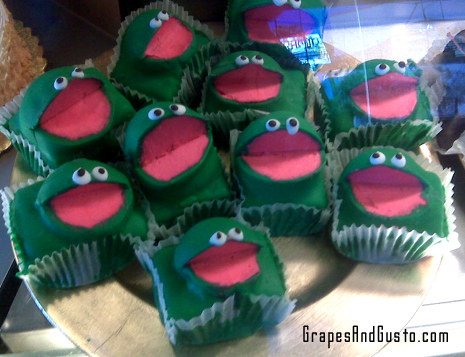

Recent comments